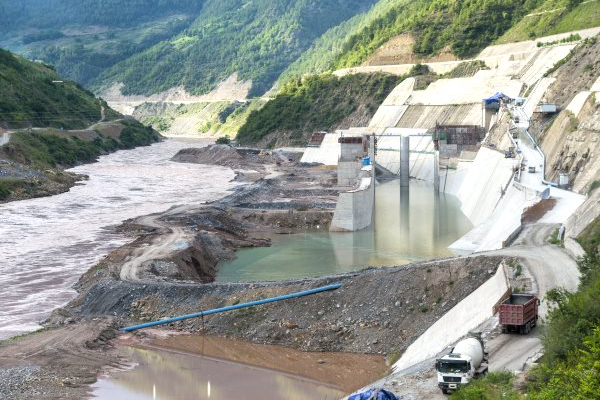
China sends glacial water from Tibet to the Maldives, raising concerns
China gifted 3,000 metric tons of Tibet’s glacial water to the island nation of the Maldives in two separate batches in March and May — the same months it unveiled and implemented water conservation regulations at home. The Water Conservation Regulations set limits on water usage within administrative regions and prioritize water conversation work in Tibet and other parts of China. They were issued by China’s State Council on March 20, a week before it sent the first delivery of 1,500 metric tons of water in jugs to the Maldives, which is experiencing a scarcity of fresh water. The regulations then went into effect on May 1, weeks before China donated the second batch of water jugs. China finalized the deal with the Maldives during a November 2023 visit by Yan Jinhai, chairman of the Tibet Autonomous Region, to the low-lying archipelago threatened by rising sea levels. The Maldives has forged strong bilateral relations with China and is a beneficiary of the Belt and Road Initiative, under which it has borrowed more than US$1 billion from Chinese banks in the past decade, according to Western think tanks. Maldivian President Mohamed Muizzu signed 20 agreements, including one for financial and military assistance, with Beijing during his inaugural state visit to China in January 2024. The Maldives thanked the people of Tibet for their “generous donation,” which it expects will greatly support its island communities. Its freshwater resources are affected by erratic rainfall patterns and rising sea levels. Water shortages in Tibet But Tibetans inside Tibet said they face water shortages themselves because Chinese authorities have implemented systematic water conservation and management campaigns across various Tibetan villages and towns for over a decade. This has occurred while authorities have restricted the availability of water and set limits on water usage at the local level. “I have heard that China is donating bottled water from Tibet to other parts of the world for free for political gain,” said one source from the Tibet Autonomous Region, where Chinese authorities have carried out water conservation campaigns for over a decade. “However, in Tibet, the local Tibetans do not have enough drinking water,” he said. “At times there isn’t enough water to even brush our teeth.” On March 27, the same day the Maldives said it received the first batch of water, the Water Conservancy Bureau of Ngari Prefecture, or Ali in Chinese, the birthplace of key South Asian rivers, began a series of year-long events for the general public to promote water conservation. In Nyingtri city, or Linzhi in Chinese, authorities have implemented the strictest water resources management system over the past several years and boast of its effectiveness. “The water used to wash rice and vegetables can be used to mop the floor and water the flowers. … Nowadays, water-saving behaviors like this have become a conscious action of many citizens,” said a 2023 announcement by the city government. Meanwhile, Tibetans who have grown up on their ancestral land in Gangkar township in Dingri county, called Tingri in Chinese, are being forced to relocate to make way for the expansion of China’s water bottling facilities and industry, two sources said. “Gangkar is known for its fertile pastureland and significant water resources from glaciers with 15 water springs in the region, which the local Tibetans have always relied on for their livelihoods,” said the first source. Chinese authorities plan to move about 430 residents to take control of the water resources from the land, he said. Weaponizing water China’s move signals it is engaging in “water politics” and playing the long game for geopolitical gains in South Asia, experts said. The Chinese government has projects underway to extract clean, clear and mineral-rich water to support the expansion of its premium mineral bottled water industry, they said. Beijing also wants to control water flows to lower riparian states such as India, Nepal, Bhutan, Bangladesh, Thailand, Vietnam, Cambodia, and Laos, to further its own aspiration of regional dominance, experts said. “The imperative to address the threat of China weaponizing water in Tibet cannot be overstated,” wrote scholars Neeraj Singh Manhas and Rahul Lad in a March report titled “China’s Weaponization of Water in Tibet A Lesson for the Lower Riparian States” in the Journal of Indo-Pacific Affairs. With approximately 87,000 dams built, China poses a historic threat, having already dammed most internal rivers, they add, while calling for proactive measures to implement enduring policies to protect these vital Tibet’s water resources. Tibet is at the forefront of China’s “water wars” in the region, said Anushka Saxena, a research analyst at the Takshashila Institution, a public policy think tank in India. Tibet’s eight major transboundary river systems have the capacity to turn China into “Asia’s water hegemon,” given that their water can be used for both domestic economic and foreign policy-related interests, as well as can be weaponized to cause harm to lower riparian states, she said. “In that light, China’s moves vis-à-vis export of water to Maldives cannot be isolated from the larger approach China is adopting to using Tibet’s water resources,” she added.


